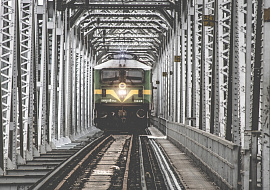CBTC-Based Signaling System: Challenges, Solutions, Expectations
Apparently, rail operators are striving to make the most out of the advanced, future-proof signaling technology offering reduced train headways and optimized energy use without heavy infrastructure spending.
CBTC is capacious, safe, and cost-effective in the long term, continuing to gain global traction. By 2025, the industry has accumulated significant experience and best practices for implementing CBTC-based signaling systems in an optimal manner. At PSA, our deep expertise in rail signaling engineering and IoT solutions enables us to design, support, and elevate CBTC systems of any complexity. We’d like to reveal the crucial signaling challenges and head-on solutions enabling safe, optimized, and secure rail operations for today and the future.
Technical Implementation Challenges of CBTC
CBTC signaling systems come with unique technical hurdles to comply with rigorous safety and performance metrics. Rail operators must tackle multiple challenges for CBTC signaling systems to keep precise control and monitoring of train movements – mainly related to field communication, security, and outdated technologies.
Communication System Reliability Issues
Communication-Based Train Control is a system where communication serves as a fundamental advantage – one that must remain uncompromised at all times. CBTC rail systems depend on extremely reliable two-way wireless communication between the train and the wayside. Critical operations just need network latency below 500 milliseconds and wireless handover time under 50 milliseconds. The system managed to keep packet loss at less than 0.1 percent. Several elements affect wireless connectivity reliability:
-
Radio frequency interference and electromagnetic disturbances
-
Signal interference and frequency congestion
-
Physical limitations in radio equipment installation
-
Environmental factors affecting GPS functionality in tunnels
-
Complex channel conditions during frequent handoffs
Integration with Legacy Systems
Connecting CBTC signaling with existing infrastructure creates complex compatibility challenges. We need specialized engineering expertise to link legacy microprocessor-based systems with modern CBTC components through obsolete protocols. These upgrades often call for additional transmission modules built specifically to work with legacy systems.
The challenge goes beyond the original setup. PLCs and their components turn into legacy products over time, which leads to compatibility problems. New components added to CBTC-involved equipment make these legacy elements behave unpredictably. All the same, replacement parts get harder to find. The obsolescence of PCMCIA shows this trend clearly – it was once a common standard for memory cards in PLCs, that now are unavailable to be replaced.
Performance Optimization Hurdles
The best CBTC performance comes from balancing multiple critical factors. Complex channel conditions and frequent handoffs substantially affect train-ground communication performance. The system must optimize both communication and control aspects while following strict safety rules for train control actions.
Environmental factors add more complexity to optimization. Train and trackside equipment must meet strict industry standards to protect against:
-
Temperature variations
-
Vibration and metallic dust
-
Moisture and electrical surges
-
Fire protection requirements
Equipment that fails these specifications can get pricey with system disruptions, shorter lifespans, and service interruptions. CBTC operations rely heavily on train-to-wayside wireless technology, making them vulnerable to signal interference and range restrictions from unpredictable radio frequency environments.
System Integration Strategies of CBTC
CBTC rail systems need reliable integration strategies to meet technical and operational requirements. A Data Communication System (DCS) is the foundation of modern CBTC implementations. It supports two-way data transfer while optimizing bandwidth and meeting ultra-low latency requirements.
Middleware Solutions for Interoperability
The lack of unified CBTC standards has pushed developers to create interoperable middleware solutions. These solutions must handle communication between different subsystems. They also need to maintain fail-free train-to-ground wireless connectivity with packet drop rates below 0.1%. The network architecture works through five distinct modules:
-
Onboard systems
-
Wayside wireless
-
Wayside access
-
Backbone networks
-
Core networks
Modern CBTC implementations make use of standardized protocols instead of proprietary solutions to boost interoperability. Ultra-Wide Band (UWB) technology has become a promising solution for train localization. It offers easy installation and less traffic interruptions.
Data Management and Synchronization
CBTC systems' data integrity needs advanced management and synchronization mechanisms. The buffer management function works as an intermediary that ensures message synchronization between Vehicle Control Units (VCU) and data servers. The synchronization process keeps data integrity through:
-
TCP handshake protocols for packet verification
-
Up-to-the-minute data parsing and validation
-
Automated recovery mechanisms for connection losses
-
Continuous monitoring of data flow integrity
Testing and Validation Approaches
Factory Acceptance Testing (FAT) is the foundation for CBTC system validation. The testing process includes detailed verification steps, visual inspections, component testing, and performance evaluations. CBTC validation needs specialized simulation environments that mirror real-life conditions, like traditional testing methods.
Automated testing facilities have played a key role in boosting system reliability. These facilities help evaluate interface integration, timetable transitions, and fault scenarios without disrupting operational services. The testing framework uses specialized tools to analyze communication between interlocking and Balise Processor (BP) systems. It generates detailed performance metrics and validation reports
Performance Optimization Methods of CBTC
Each year, thousands of equipment-related ISF failures are recorded across the U.S., significantly impacting overall network performance.
Modern CBTC rail systems need sophisticated performance optimization methods to keep peak operational efficiency. These systems achieve remarkable improvements in service reliability through advanced monitoring and maintenance strategies.
Real-time Monitoring Solutions
CBTC systems excel at precise train positioning and give operators detailed immediate information about train locations. The Operations Control Center manages to keep consistent near or above 90% on-time performance with this capability. The system delivers these benefits through continuous wireless communication between trains and wayside equipment:
Enhanced Operational Control: The computerized automatic train operation (ATO) system reduces variations in train operation patterns. Trains maintain optimal speeds and spacing because of this standardization. This leads to shorter wait times and reduced crowding.
Dynamic Speed Management: The system adjusts train speeds automatically based on immediate conditions. Operators can maximize line capacity without compromising safety protocols. We've enhanced this feature to allow trains to operate in closer proximity while maintaining higher speeds.
The flexible, digital nature of CBTC allows for the seamless integration of IoT solutions for advanced, real-time asset monitoring. Tracks, level crossings, interlocking equipment, and more can be equipped with IoT sensors to continuously report operational, environmental, and other data critical for maintenance.
Predictive Maintenance Strategies
A piece of data on wayside signals: According to MTA, their maintenance and testing annually cost $168k per mile, considering mostly overtime character for maintenance activities. Level 3 diagnostics marks the most important advancement in CBTC maintenance approaches. Each Line Replaceable Unit (LLRU) gets a normal operating baseline through historical data analysis. Maintenance teams can now:
-
Monitor voltage fluctuations in power supplies
-
Track speed sensor pulse patterns
-
Analyze equipment performance trends
-
Record telemetry data to investigate incidents
The predictive maintenance algorithm on the Data Management System (DMS) processes extensive operational data to forecast potential failures. This approach ended up helping maintenance personnel plan corrective actions proactively and minimize service disruptions.
System Reliability Enhancement
CBTC implementations show substantial improvements in system reliability metrics. The first lines converted to CBTC consistently achieve on-time performance rates near or above 90%. Several key factors drive these improvements:
Automated Recovery Procedures: The system quickly identifies and responds to operational issues which reduces downtime. The control center initiates predetermined recovery protocols when it detects anomalies. This ensures minimal service interruption.
Energy Optimization: CBTC systems reduce unnecessary acceleration and braking through automatic speed regulation. This achieves over 20% reduction in energy consumption. The optimization improves operational efficiency and contributes to environmental sustainability.
Performance Monitoring: The system reviews critical parameters continuously. These include network latency (kept below 500 milliseconds) and wireless handover time (under 50 milliseconds). These strict performance metrics ensure reliable communication between all system components.
Ultra-Wideband (UWB) radio technology represents the next development in CBTC optimization. This groundbreaking advancement promises simultaneous ground-to-train communication, precise train location tracking, and improved obstacle detection capabilities. These features further enhance system reliability and operational efficiency
Signaling Security Framework of CBTC
Recent cybersecurity directives from the Transportation Security Administration show an increased focus on protecting rail infrastructure. Note that the October 2023 directive SD 1580/82-2022-01 requires passenger and freight railroad carriers to implement layered cybersecurity measures.
Cybersecurity Threat Landscape
CBTC operations' digitization has created more potential attack surfaces. Cyberattacks targeting vital rail systems can lead to complete operational shutdowns and put human safety at risk. CBTC systems face multiple vulnerabilities:
-
Train-to-ground wireless communications susceptible to denial-of-service attacks
-
Proprietary protocols that lack built-in security measures
-
Integration points with legacy systems that create potential breach points
-
Maintenance interfaces exposing debug ports and hidden features
Modern CBTC implementations differ from traditional isolated systems. They heavily rely on wireless communications and interconnected networks, which makes them more vulnerable to external attacks.
Risk Assessment Methodologies
At PSA, we’re guided by the CENELEC TS 50701 framework which offers the first complete standard to manage cybersecurity risks in railway systems. This framework uses a seven-step Zone and Conduit Requirements (ZCR) process to review and enhance security posture. The methodology focuses on:
-
Identifying critical system components and communication pathways
-
Reviewing threats specific to each operational zone
-
Determining required security levels for different system areas
-
Implementing appropriate countermeasures
Security Control Implementation
Security controls need a multi-layered approach. Full penetration testing has shown that segmented networks and proprietary software just need specialized security measures. Key security implementations include:
- Access Control Systems: Multi-Factor Authentication (MFA) solutions that prove right all interaction sides.
- Encryption Protocols: Key Management Systems (KMS) that distribute cryptographic keys between railway devices and ensure secure data transmission.
- Network Segmentation: Distinct security zones with controlled communication conduits between different operational areas.
- Monitoring Solutions: Live threat detection systems that can analyze both application-level and network-level threats.
These security measures line up with national cybersecurity authority requirements while maintaining CBTC network's performance and safety standards.
Conclusion about CBTC signaling systems
CBTC signaling systems are a firm standard of modern rail operations. They turn traditional fixed-block systems into dynamic and efficient networks. These systems deliver remarkable improvements in operational efficiency and maintain strict safety standards through advanced communication protocols and immediate monitoring capabilities.
PSA ensures system reliability, security, and optimal performance. The company provides detailed solutions to handle the technical challenges of CBTC implementation. Strong wireless communication, continuous integration with legacy systems, and strong cybersecurity measures are the foundations of effective CBTC deployments.
-
Our expertise covers these critical areas:
-
Ultra-reliable train-to-wayside communication with sub-500ms latency
-
Integration strategies for legacy system compatibility
-
Multi-layered security frameworks arranged with TSA directives
-
Advanced performance optimization methods
-
Predictive maintenance solutions
Rail operators worldwide trust PSA's proven track record in CBTC integration. We create customized solutions that meet specific operational requirements and ensure long-term system sustainability. PSA remains committed to advancing signaling technology as rail networks expand. We support the industry's development toward safer and more efficient operations















